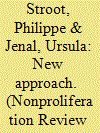|
|
|
Sort Order |
|
|
|
Items / Page
|
|
|
|
|
|
|
| Srl | Item |
| 1 |
ID:
107567


|
|
|
|
|
| Publication |
2011.
|
| Summary/Abstract |
This introductory article first provides an overview of key historical developments pertaining to the Biological Weapons Convention (BWC), exposing the roots of the assertion that the treaty is unverifiable. The article also reviews the factors that have changed since the BWC's negotiation, including those that loom over the BWC's effective implementation today, with special emphasis on the challenges posed by the advancement and global diffusion of life sciences know-how, technologies, equipment, and capabilities. The narrative concludes with a description of the methodology behind this special issue of the Nonproliferation Review, introducing the contributing authors and the common questions they address in the context of their topics.
|
|
|
|
|
|
|
|
|
|
|
|
|
|
|
|
| 2 |
ID:
107572


|
|
|
|
|
| Publication |
2011.
|
| Summary/Abstract |
This article describes the status of biosafety, biosecurity, and biorisk management worldwide and, considering the difficulties of enforcing and monitoring compliance with the Biological Weapons Convention (BWC), analyzes how institutions' effective biorisk management can help in responding to concerns regarding the prevention of the development of bioweapons that would otherwise be difficult to address. The biorisk management approach aims to ensure responsible, safe, and secure handling of biological materials. Developed with the support of the life sciences community, it contributes to the objectives of international organizations to respond to natural or deliberate biological threats to public health and the environment. Achieving effective biorisk management across all institutions still requires increased awareness at the highest level, as well as allocation of appropriate resources and efforts in both biosafety and biosecurity training and development and transfer of expertise. However, establishing and valuing a culture of ethical and safe behavior and implementing effective biorisk management appear likely to prevent misuse of biological materials and significantly improve control of potential dual-use issues in the life sciences community. For these reasons, the BWC should not only encourage state parties to take a more active part in ensuring the development of biosafety, biosecurity, and biorisk management, but also promote relevant non-state actor programs.
|
|
|
|
|
|
|
|
|
|
|
|
|
|
|
|
|
|
|
|
|